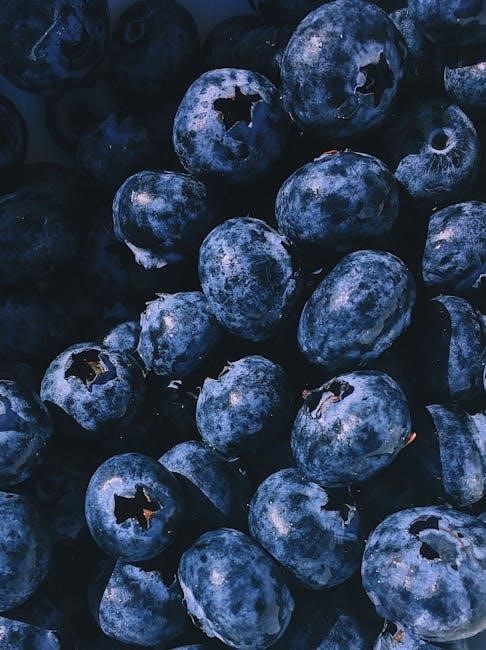SCD Diet Food List PDF: A Comprehensive Guide
Embark on your Specific Carbohydrate Diet (SCD) journey with a comprehensive guide! Accessing an SCD diet food list PDF offers invaluable support. This resource details allowed and restricted foods, crucial for managing conditions like Crohn’s and ulcerative colitis, promoting gut health and overall well-being.
The Specific Carbohydrate Diet (SCD) is a restrictive dietary approach designed to manage gastrointestinal conditions. These conditions include Crohn’s disease, ulcerative colitis, and celiac disease. It aims to reduce inflammation and restore gut health by eliminating complex carbohydrates that can fuel harmful bacteria in the digestive system.
This diet focuses on easily digestible foods, primarily monosaccharides, promoting better nutrient absorption and reducing fermentation in the gut. The SCD has gained popularity as a complementary therapy, offering potential relief from digestive symptoms and improving overall quality of life.
By adhering to the SCD principles and utilizing resources like SCD diet food list PDFs, individuals can navigate the diet effectively. They can make informed food choices, and manage their conditions proactively. The diet emphasizes whole, unprocessed foods and careful food introduction stages, adapting to individual tolerances for optimal results.
Understanding the SCD Principles
The Specific Carbohydrate Diet (SCD) operates on the principle of restricting complex carbohydrates. These complex carbohydrates include disaccharides and polysaccharides, which can be difficult for some individuals to digest. By eliminating these, the diet aims to starve harmful bacteria in the gut, reducing inflammation and promoting healing of the intestinal lining.

A key principle is consuming only monosaccharides, such as glucose, fructose, and galactose, as they are easily absorbed. This reduces the amount of undigested food available for bacterial fermentation.

The SCD also emphasizes the importance of whole, unprocessed foods. This avoids additives and artificial ingredients that can exacerbate digestive issues. Gradual food introduction is another crucial aspect, allowing individuals to identify specific food intolerances and tailor the diet to their unique needs. Resources like SCD food list PDFs are essential for navigating these principles effectively.
Allowed Foods on the SCD: A Detailed Breakdown
Navigating the Specific Carbohydrate Diet (SCD) requires a clear understanding of permissible foods. This detailed breakdown offers clarity, ensuring successful implementation of the dietary guidelines. Central to the SCD are naturally occurring, unprocessed options.
Fruits form a cornerstone, with most fresh varieties being SCD-legal, aligning with the diet’s emphasis on easily digestible monosaccharides. Vegetables, too, play a significant role, although careful selection is necessary to exclude those high in restricted carbohydrates. Proteins, including meats, poultry, fish, and eggs, are foundational, provided they are free from additives. Certain dairy products, like aged cheeses and homemade yogurt fermented for over 24 hours to reduce lactose, are permitted.
Furthermore, nuts and seeds, prepared appropriately, contribute healthy fats and nutrients. Oils, spices, and herbs enhance culinary options while adhering to SCD principles. Consulting an SCD food list PDF provides comprehensive guidance for making informed choices within these categories.
Fruits and Vegetables: SCD-Legal Options
The Specific Carbohydrate Diet (SCD) emphasizes selecting specific fruits and vegetables that are easier to digest. Most fresh fruits are allowed, aligning with the SCD’s focus on monosaccharides. Apples, bananas (ripe, with brown spots), berries, grapes, oranges, peaches, and pears are generally well-tolerated and encouraged.
Vegetables require more careful consideration. SCD-legal options include asparagus, avocados, bell peppers, broccoli, carrots, celery, cucumbers (peeled and seeded), eggplant, green beans, lettuce, mushrooms, spinach, squash, tomatoes, and zucchini. It is important to avoid starchy vegetables like potatoes, sweet potatoes, and parsnips due to their complex carbohydrate content.
Always consult a comprehensive SCD food list PDF for a complete and up-to-date reference, as individual tolerances may vary. Introduce new fruits and vegetables gradually to monitor for any adverse reactions, ensuring optimal digestive health while adhering to the SCD principles. Proper preparation, such as peeling and cooking, can also aid in digestibility.
Proteins: Meats, Poultry, Fish, and Eggs
Proteins form a cornerstone of the Specific Carbohydrate Diet (SCD), providing essential nutrients while adhering to the diet’s carbohydrate restrictions. When selecting meats, poultry, and fish, prioritize fresh, unprocessed options without additives. Look for meats without added sugars, starches, or preservatives. Acceptable choices include beef, chicken, turkey, lamb, and pork, prepared by baking, grilling, or stewing.
Fish and shellfish are excellent SCD-legal protein sources. Opt for wild-caught varieties whenever possible, avoiding those with breading or sugary marinades. Salmon, tuna, cod, shrimp, and scallops are good choices. Eggs are also permissible and versatile, suitable for various preparations like omelets, scrambled eggs, or hard-boiled eggs.
Carefully review SCD food list PDFs for specific guidelines on acceptable protein products. Always choose whole, unprocessed foods. Be mindful of hidden ingredients that could violate the diet. Introducing protein sources gradually and monitoring for any adverse reactions is crucial for personalizing the SCD to individual tolerances and ensuring optimal digestive health.
Dairy: Acceptable and Restricted Choices
Navigating dairy on the Specific Carbohydrate Diet (SCD) requires careful attention, as many conventional dairy products are restricted due to their lactose content. The SCD aims to limit complex carbohydrates, including lactose, to promote gut healing. However, certain dairy options are permissible after undergoing a fermentation process that reduces lactose levels.
Specifically, homemade yogurt fermented for at least 24 hours is a cornerstone of the SCD dairy allowance. This extended fermentation breaks down lactose, making it more digestible. Dry curd cottage cheese is also generally accepted, as it naturally contains less lactose. Hard, aged cheeses like cheddar, parmesan, and Swiss are often tolerated in moderation due to their low lactose content.

However, most milk, soft cheeses (like ricotta and cream cheese), and processed dairy products are prohibited on the SCD due to their high lactose levels and potential additives. Always consult an SCD food list PDF for a comprehensive guide. Introduce dairy products cautiously and monitor for any adverse reactions, as individual tolerances vary significantly.
Nuts and Seeds: Navigating SCD-Compliance
Nuts and seeds can be valuable additions to the Specific Carbohydrate Diet (SCD), offering healthy fats and nutrients. However, SCD compliance requires careful selection and preparation. Most raw, unroasted nuts and seeds are allowed, including almonds, walnuts, pecans, and sunflower seeds. These provide beneficial fats and can be used in baking or as snacks.
It’s crucial to avoid nuts and seeds coated with sugar, honey, or other restricted ingredients. Check labels carefully to ensure no prohibited additives are present. Some individuals may find certain nuts, like cashews and pistachios, more difficult to digest, so moderation is key. Nut flours, like almond flour, are often used in SCD baking as grain-free alternatives.
Seeds, such as chia seeds and flaxseeds, are also permissible and can be incorporated into meals. Always consult an SCD food list PDF for detailed guidance. Remember to introduce new nuts and seeds gradually to monitor for any adverse reactions, as individual tolerances can vary. Proper preparation and mindful consumption are essential for successful SCD adherence.
Foods to Avoid on the SCD: The “Illegal” List
Adhering to the Specific Carbohydrate Diet (SCD) necessitates a clear understanding of foods to avoid, often referred to as the “illegal” list. This list primarily includes complex carbohydrates and processed items that can feed harmful bacteria in the gut, exacerbating conditions like Crohn’s disease and ulcerative colitis.
Grains are strictly prohibited on the SCD, including wheat, rice, corn, oats, and barley. This restriction extends to all products made from these grains, such as bread, pasta, and cereals. Most legumes, including beans, lentils, and peas, are also excluded due to their complex carbohydrate content. However, some exceptions exist, which will be discussed later;
Processed foods are generally off-limits due to the presence of additives, preservatives, and refined sugars. These ingredients can disrupt the gut microbiome and hinder the healing process. It is crucial to carefully read food labels and avoid products containing sucrose, fructose, lactose, maltose, and other disallowed sugars. Sticking to whole, unprocessed foods is key to SCD success. Refer to a detailed SCD food list PDF for comprehensive guidance on “illegal” foods.
Grains and Starches: Strict Restrictions
A cornerstone of the Specific Carbohydrate Diet (SCD) is the strict restriction of grains and starches. This prohibition stems from the SCD’s core principle of limiting complex carbohydrates that can fuel harmful bacteria in the gut, contributing to inflammation and digestive issues. Grains, being a primary source of complex carbohydrates, are therefore excluded.
All common grains are off-limits, including wheat, rice, corn, oats, barley, rye, and spelt. This restriction extends to all products derived from these grains, such as bread, pasta, cereals, crackers, and pastries. Gluten-free alternatives made from restricted grains are also prohibited. The SCD aims to eliminate all complex carbohydrates that are not easily digestible, thus promoting a healthier gut environment.
Starchy vegetables, such as potatoes, sweet potatoes, and parsnips, are also excluded from the SCD due to their high starch content, which breaks down into sugars. Arrowroot powder and tapioca starch, often used as thickening agents, are similarly disallowed. Maintaining a grain-free and starch-free diet is crucial for achieving the desired results on the SCD. Consult an SCD food list PDF for a complete list of restricted grains and starches.
Legumes: Which are Allowed and Which are Not

Navigating legumes on the Specific Carbohydrate Diet (SCD) requires careful attention, as some are permitted while others are strictly prohibited. The key lies in the digestibility of the legume’s carbohydrate structure. Certain legumes contain complex carbohydrates that are difficult to break down, potentially feeding harmful bacteria in the gut and exacerbating digestive issues.
Generally, dried legumes are restricted in the initial stages of the SCD. However, some legumes, after proper preparation and cooking, can be introduced later on. Allowed legumes typically include lima beans, navy beans, and lentils, but only after they have been soaked for at least 24 hours and thoroughly cooked to break down complex carbohydrates. Always start with small portions to assess tolerance.
Legumes to avoid on the SCD include chickpeas, soybeans, mung beans, fava beans, and canned beans (unless specifically prepared according to SCD guidelines). These legumes contain complex sugars that are difficult to digest and can contribute to gut inflammation. Always consult a detailed SCD food list PDF for a comprehensive guide, and remember that individual tolerances may vary. Introduce new legumes gradually and monitor for any adverse reactions.
Processed Foods and Additives: Staying Away
A cornerstone of the Specific Carbohydrate Diet (SCD) is the avoidance of processed foods and artificial additives. These substances often contain complex carbohydrates, refined sugars, and synthetic ingredients that can disrupt gut health and hinder the healing process. SCD emphasizes whole, unprocessed foods to minimize inflammation and promote a balanced gut microbiome.
Processed foods frequently include hidden sources of disallowed ingredients, such as starches, artificial sweeteners, and preservatives. These additives can feed harmful bacteria in the gut, contributing to symptoms like bloating, gas, and abdominal pain. Reading labels meticulously is crucial to identify and avoid these hidden offenders. Be wary of pre-packaged snacks, canned goods, and processed meats, as they often contain prohibited ingredients.
Staying away from processed foods and additives requires a commitment to preparing meals from scratch using SCD-legal ingredients. Focus on fresh fruits, vegetables, meats, and homemade broths. By prioritizing whole foods and avoiding artificial substances, you can support the SCD’s goal of restoring gut health and alleviating digestive symptoms. Consult an SCD food list PDF for a comprehensive guide on identifying and avoiding prohibited ingredients in processed foods.
The Specific Carbohydrate Diet (SCD) involves a strategic approach to food introduction, often visualized in stages. Although not formally defined with rigid stages beyond the introductory diet, many individuals adopt a phased approach to minimize digestive upset and identify potential intolerances. The initial phase typically involves easily digestible foods like homemade chicken broth, well-cooked chicken, and strained applesauce. This allows the gut to rest and begin the healing process.
As symptoms improve, new foods are gradually introduced, one at a time, to monitor tolerance. This cautious approach helps pinpoint specific foods that may trigger adverse reactions. It’s essential to proceed slowly and observe any changes in bowel movements, bloating, or overall well-being. Introducing foods in small quantities and waiting a few days before adding another new item is recommended.
While there aren’t official SCD stages beyond the initial introduction, resources such as pecanbread.com provide frameworks for gradual food advancement. Remember to listen to your body’s signals and adjust the pace of introduction accordingly. Consulting an SCD food list PDF and working with a healthcare professional can provide valuable guidance throughout this process, ensuring a personalized and effective dietary approach.
Modifications and Individual Tolerances on the SCD
The Specific Carbohydrate Diet (SCD) isn’t a one-size-fits-all approach. Individual responses to various foods can differ significantly, necessitating modifications to the standard SCD food list. What works well for one person might trigger symptoms in another. Factors such as the severity of gut inflammation, pre-existing conditions, and overall health can influence tolerance levels.
Therefore, it’s crucial to view the SCD as a framework rather than a rigid set of rules. Experimentation and careful observation are key to identifying personal tolerances. Some individuals may find that they can tolerate certain legumes or dairy products, while others need to avoid them strictly. Emerging research continues to refine our understanding of food sensitivities and their impact on gut health.
Many people modify the diet based upon how they feel, and it is important to listen to your body! An SCD food list PDF can serve as a helpful starting point, but it’s essential to tailor the diet to your specific needs. Remember that tolerances can change over time, so periodically re-introducing previously intolerant foods may be worth considering. Consulting with a healthcare professional or registered dietitian experienced in SCD can provide personalized guidance and support in navigating these modifications.
Resources for SCD Food Lists and Recipes (PDFs)
Navigating the Specific Carbohydrate Diet (SCD) becomes significantly easier with access to reliable resources. Luckily, numerous SCD food lists and recipe PDFs are available online to guide you through the dietary restrictions and inspire your meal planning. These resources often compile comprehensive lists of allowed and prohibited foods, saving you time and effort in deciphering what’s SCD-legal.
Many websites and organizations dedicated to the SCD offer downloadable PDFs containing detailed food lists, categorized by food groups such as fruits, vegetables, proteins, and dairy. Some PDFs also include introductory guides to the SCD, meal plans, and tips for successful implementation. Recipe PDFs are invaluable for discovering creative and delicious ways to prepare SCD-compliant meals.
These resources often provide step-by-step instructions and ingredient lists, making it easier to adapt your favorite dishes to fit the SCD guidelines. When searching for SCD resources, consider reputable sources such as the Specific Carbohydrate Diet Association (SCDA) and websites dedicated to gut health and inflammatory bowel disease (IBD). Always verify the information with your healthcare provider to ensure it aligns with your individual needs and medical history.
The SCD Association and Community Support
Embarking on the Specific Carbohydrate Diet (SCD) can feel overwhelming, but the Specific Carbohydrate Diet Association (SCDA) provides crucial support and resources. The SCDA, a US IRS 501(c)(3) nonprofit, raises awareness about the SCD’s benefits and unifies the community. This includes followers, parents, caregivers, doctors, clinicians, companies, and others worldwide.
Joining the SCD community offers invaluable benefits. You can connect with others who understand the challenges and triumphs of the diet. Sharing experiences, recipes, and tips can significantly ease the transition and enhance adherence. Online forums, social media groups, and local chapters provide platforms for interaction and mutual encouragement.
The SCDA offers various resources, including educational materials, research updates, and a directory of healthcare professionals familiar with the SCD. They also organize events and conferences, fostering a sense of community and providing opportunities for learning and networking. Remember, you’re not alone on this journey. The SCDA and the wider SCD community are there to support you every step of the way.
